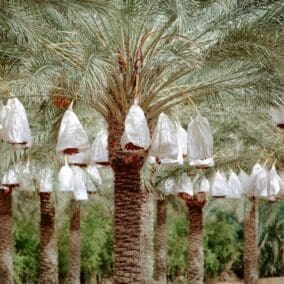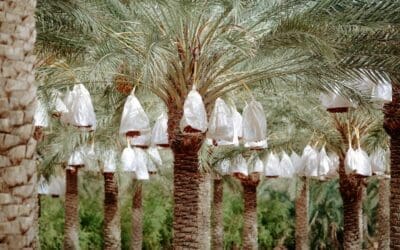Date Farming in the UAE: Its Significance and History
Discover the rich cultural heritage and significance of dates in the UAE, the nation's official fruit, cultivated through labor-intensive traditional…







Home » Blog » Blogs » Arts & Culture » Traditional Dhow Building in Ras Al Khaimah
Explore the enduring legacy of dhow building in Ras Al Khaimah, tracing its vital role in the region’s ancient pearling and maritime trade. This overview delves into the traditional craftsmanship of these iconic Arab sailboats, their modernization for cargo, racing, and tourism, and how the industry continues to adapt while preserving its profound cultural significance in the UAE.

On 5 March 2010, a 30-meter-long, 9-meter-tall dhow with a capacity of 800 tonnes and a price tag of AED 2.5 million was successfully launched from the Maaridh harbor in Ras Al Khaimah. Every day for several days leading up to the event, the crew waited for low tide and laboriously pushed, pulled, and moved the boat using wooden planks, rollers, and pulleys from where it was built high up on the beach and down to the waterline.
Dhow building is an integral part of the history of Ras Al Khaimah and was once one of the emirate’s major industries. That 2010 launch of the 30-meter dhow was a bittersweet moment because Mohammed Bu Haji, the yard owner and Ras Al Khaimah’s last known dhow builder, declared that would probably be his last dhow.
Note: It wasn’t. In 2011, he started building another dhow.
The golden age of traditional dhow building in Ras Al Khaimah has indeed passed, but it is not forgotten. Today, dhows continue to ferry goods to local markets, make short-sea shipping hops, and integrate with international shipping networks. They are also celebrated in annual dhow races and have found a niche in tourism.
The traditional dhow is a single- or double-masted Arab sailboat made of wood, typically teak and coconut, with lateen rigging (i.e., triangular sails mounted at an angle to the mast). It is an ocean-going vessel with exquisite carvings, a showcase of traditional Arab craftsmanship. The lower Gulf region used it extensively in the Arabian Gulf, Red Sea, and Indian Ocean.
Ras Al Khaimah, which has been continuously inhabited for more than 7,000 years since the Ubaid period, is the current site of the ancient port town of Julfar. Julfar served as a gateway to Southeast Arabia and a significant maritime trading post.
The people of Ras Al Khaimah and the rest of the lower Gulf settlements fished and dived for pearls. Ras Al Khaimah merchants sailed the seas and plied their pearls (also Julfar pottery) in the Gulf and Indian Ocean trade routes. For all these activities, they needed boats.
Traditional Arab dhows met this fundamental requirement. During the pearling season, thousands of dhows roamed the Arabian Gulf and the surrounding seas for pearl diving. They connected Ras Al Khaimah and the lower Gulf region to the upper Gulf, parts of Africa, India, and parts of Asia.
In this context, dhow building in Ras Al Khaimah and other parts of the UAE naturally developed. Ras Al Khaimah’s craftsmen built the dhows, and the area supplied the maritime trade with sailors and dhow captains. Dhow building became a calling and a vocation that families handed down from generation to generation.
The commercial production of Japanese cultured pearls and the Great Depression diminished demand for the Gulf region’s pearls. This had a devastating effect on the Gulf’s pearling industry and grounded many pearling dhows. Eventually, the discovery of oil reserves in the Arabian Gulf permanently shifted the economic focus from pearling to oil exploration and extraction in the UAE.
The dhow lost one of its primary functions: transporting the divers and merchants of the pearl trade. Even so, dhow building in the UAE continued. In Ras Al Khaimah, dhow building remained a major industry alongside the manufacture of cement and Ras Al Khaimah ceramics.
However, eventually, container shipping lines took over international trade routes. Modern sea vessels also became available. Consequently, the dhow took a secondary role in maritime trading and shipping.
Yes, they remain an integral part of maritime cargo transport in the UAE, with dhow fleets and shipping networks in the Gulf complementing instead of competing with standard shipping lines. Dhow racing has also become a celebrated event in the UAE, and dhow sunset and sightseeing cruises have become one of the top things to do in Ras Al Khaimah and the rest of the UAE.
Even so, the industry of traditional dhow building in Ras Al Khaimah and the UAE has become a shadow of its former glory.
What is dhow building like when done the traditional way? Logs of seasoned teak are blocked or squared to create planks, which are bent into shape and fitted edge-to-edge to create the hull or the shell. There should be minimal gaps between the timbers.
There were no drawings or blueprints. Instead, a master builder like Mohammed Bu Haji above supervises and directs the work of the crew.
Once the frame is complete, the boat is built part by part, section by section, and then buffed and sanded by skilled craftsmen. To protect the dhow from barnacles and other marine growth, the bottom part of the hull that lies below the waterline is treated with lime and traditionally, the hull is varnished (it takes numerous coats) but not painted.Note that traditional dhow building meant using simple hand tools like hammer, chisel, and adze. The adze was used to cut off smaller wood pieces from larger blocks, smooth rough surfaces, and shape wood on demand.
The completed dhow was also launched the traditional way. Workers wait for the low tide every day and, in a process that takes several days of hard work, they move the boat from above the high-tide line into the water.
This is why it takes months and years of hard work to make a single traditional dhow. The arduous and painstaking process of cutting, shaping, and assembling the boat plank by plank, rib by rib, also meant fewer younger people inheriting the trade from their parents or grandparents, especially with the youth enjoying many trade and professional options today.
Dhow building continues as an industry, particularly to make, repair, and restore racing dhows, small fishing vessels and bigger-sized tourist boats. However, the process has evolved with the times.
Many transportation and cargo dhows have swapped their lateen rigging for propellers and diesel engines. Racing dhows retained the rigging, but they did exchange their sail-support spars for ones made of aluminum or carbon fiber and their cotton sails for polyester cloth. The boums or booms (large, seaworthy dhows) now have steel “I” beams. Even the traditional tools have been displaced in favor of modern implements, such as planing machines, grinders, bandsaws, and marine polishers and buffers.
Dhows are proof of the Arab people’s Arab ingenuity and seafaring legacy, and they’re a remnant of the region’s rich pearling and pearl trading history. This is why dhow building is important in the UAE and why dhows remain a significant presence in the country.
The traditional process of making dhows has been modified to incorporate modern materials, tools, and techniques, but the important thing is that dhows continue to traverse the coast of the Arabian Peninsula. More importantly, the spirit of traditional dhow building persists, albeit at a smaller scale, in the UAE.
The Ras Al Khaimah Tourism Development Authority provides information about things to do in Ras Al Khaimah. Explore our website to learn about the best outdoor activities and places to visit in Ras Al Khaimah. If you can swing it, arrange a visit to the National Museum of Ras Al Khaimah, where you can see dhow artifacts and learn more about this traditional seafaring vessel, and the Suwaidi Pearl Farm to learn about pearl fishing and one of the trades that made Ras Al Khaimah popular in the ancient maritime trade.
Explore the Visit Ras Al Khaimah website now.


Discover the rich cultural heritage and significance of dates in the UAE, the nation's official fruit, cultivated through labor-intensive traditional…